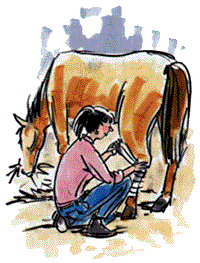|
 For
an outer wrap you will want to use flannel simply because it
will not allow you to pull it too tight. Although easy to
use, stretch bandages are bad since they do more damage than
good to your horseís limbs. Bandage pins are akin to diaper
pins, and each bandage will require two pins. For
an outer wrap you will want to use flannel simply because it
will not allow you to pull it too tight. Although easy to
use, stretch bandages are bad since they do more damage than
good to your horseís limbs. Bandage pins are akin to diaper
pins, and each bandage will require two pins.
Now that you have accumulated the necessary materials,
here is how you will want to apply the bandage:
1. Restrain the animal and sit next to the limb that you
will bandage.
2. Clean the affected limb and brush the hair so that it
is lying down.
3. Next you will want to roll up the cotton and flannel.
Obviously, this will help you to work easier when applying
them, but when rolling them for use be sure to put on the
inside what you will want to have on the outside later on.
By way of a hint, the shaggy side of the flannel should be
on the outside when you put on the bandage.
4. When you reuse a bandage for an animal that is treated
nightly, keep track of which bandage goes on which limb,
since the material will begin to conform. Yet if the cotton
is soiled or simply becomes flattened, you will need to
replace it.
5.  Position
the cotton so that the top reaches just below the knee and
the bottom just below the pastern. Begin unrolling your
cotton from the inside of the leg, and keep it close to the
limb as you are working. The flannel on the other hand
should be placed in between the pastern and knew, permitting
you to wrap once around the leg going in the same direction
as the cotton. To assist you in maintaining the cottonís
position, you might want to consider tucking an edge of the
flannel underneath the cotton. Position
the cotton so that the top reaches just below the knee and
the bottom just below the pastern. Begin unrolling your
cotton from the inside of the leg, and keep it close to the
limb as you are working. The flannel on the other hand
should be placed in between the pastern and knew, permitting
you to wrap once around the leg going in the same direction
as the cotton. To assist you in maintaining the cottonís
position, you might want to consider tucking an edge of the
flannel underneath the cotton.
6. Once you wrapped once around the limb and the cotton
looks anchored, work down the leg rather than upward.
Flannel should be applied over half of the previous go
around to make sure that no line of tension is being formed.
7. Once you reach the bottom edge of the cotton, you want
to make sure that the flannel and the cotton line up. Then
you will be able to once again work upward the same limb. As
you line up the flannel with the cotton, make sure that you
do not leave too much hanging loose since the animal might
decide to chew on it.
8. Now you are ready to place a pin on the flannel on the
outside of the leg in front of the tendon since the animal
will not be able to remove it with its teeth. The pointy
edge should be facing down and you will need to ensure that
you stick through enough material that it will not loosen
up.
9. Now feel your handiwork and make certain that the
bandage is firm but not so tight as to cut off the
circulation. Similarly, you want to make sure that it is not
so lose that it will shift on the limb as the horse moves at
night. If you can fit two fingers underneath the bandage
right under the pastern, and if you can fit only one finger
underneath the bandage on the top, you have done a good job.
For those horses that simply cannot resist the urge to
chew on their bandages, a popular remedy is soap as well as
red pepper mixed with water. This will prevent the animal
from taking off the bandage or getting hurt with the pin. If
your animal has never been bandaged before, it might panic
because of the tight feeling around its legs, and you may
need to calm it down by walking it around gently.

|